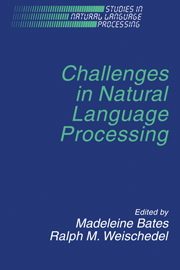Preface
Published online by Cambridge University Press: 05 March 2010
Summary
Throughout most of the 1960s, 1970s, and 1980s, computational linguistics enjoyed an excellent reputation. A sense of the promise of the work to society was prevalent, and high expectations were justified by solid, steady progress in research.
Nevertheless, by the close of the 1980s, many people openly expressed doubt about progress in the field. Are the problems of human language too hard to be solved even in the next eighty years? What measure(s) (other than the number of papers published) show significant progress in the last ten years? Where is the technology successfully deployed in the military, with revolutionary impact? In what directions should the field move, to ensure progress and avoid stagnation?
The symposium
A symposium on Future Directions in Natural Language Processing was held at Bolt Beranek and Newman, Inc. (BBN), in Cambridge, Massachusetts, from November 29, 1989, to December 1, 1989.
The symposium, sponsored by BBN's Science Development Program, brought together top researchers in a variety of areas to discuss the most significant problems and challenges that will face the field of computational linguistics in the next two to ten years. Speakers were encouraged to present both recently completed and speculative work, and to focus on topics that will have the most impact on the field in the coming decade. They were asked to reconsider unsolved problems of long standing as well as to present new opportunities. The purpose was to contribute to long-range planning by funding agencies, research groups, academic institutions, graduate students, and others interested in computational linguistics.
The thirty-six symposium attendees, who are listed following this preface, were all invited participants.
- Type
- Chapter
- Information
- Challenges in Natural Language Processing , pp. vii - ixPublisher: Cambridge University PressPrint publication year: 1993

